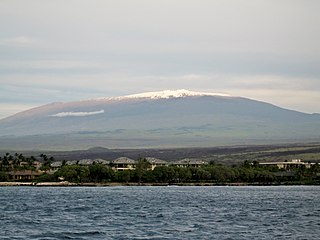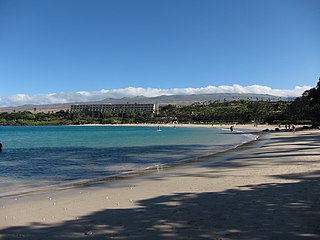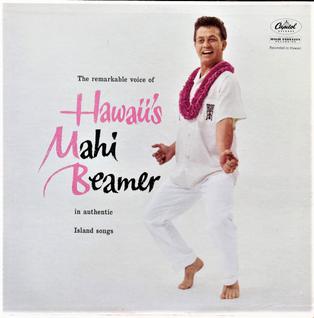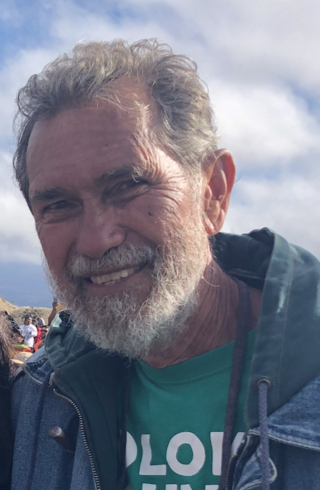
Hawaii is the largest island in the United States, located in the state of Hawaii. It is the southeasternmost of the Hawaiian Islands, a chain of volcanic islands in the North Pacific Ocean. With an area of 4,028 square miles (10,430 km2), it has 63% of the Hawaiian archipelago's combined landmass. However, it has only 13% of Hawaiʻi's population. The island of Hawaiʻi is the third largest island in Polynesia, behind the north and south islands of New Zealand.

Hilo is a census-designated place (CDP) and the largest settlement in Hawaii County, Hawaii, United States, which encompasses the Island of Hawaiʻi. The population was 44,186 according to the 2020 census. It is the fourth-largest settlement in the state of Hawaii and largest settlement in the state outside of Oahu.

The University of Hawaiʻi System, formally the University of Hawaiʻi and popularly known as UH, is a public college and university system that confers associate, bachelor's, master's, and doctoral degrees through three universities, seven community colleges, an employment training center, three university centers, four education centers and various other research facilities distributed across six islands throughout the state of Hawaii in the United States. All schools of the University of Hawaiʻi system are accredited by the Western Association of Schools and Colleges. The UH system's main administrative offices are located on the property of the University of Hawaiʻi at Mānoa in Honolulu CDP.

Mauna Kea is an active volcano on the island of Hawaiʻi. Its peak is 4,207.3 m (13,803 ft) above sea level, making it the highest point in the state of Hawaiʻi and second-highest peak of an island on Earth. The peak is about 38 m (125 ft) higher than Mauna Loa, its more massive neighbor. Mauna Kea is unusually topographically prominent for its height: its wet prominence is fifteenth in the world among mountains, at 4,205 m (13,796 ft); its dry prominence is 9,330 m (30,610 ft). This dry prominence is greater than Mount Everest's height above sea level of 8,848.86 m (29,032 ft), and some authorities have labelled Mauna Kea the tallest mountain in the world, from its underwater base.

Keola Beamer is a Hawaiian slack-key guitar player, best known as the composer of "Honolulu City Lights" and an innovative musician who fused Hawaiian roots and contemporary music. Keola Beamer descends from one of Hawaii's most respected musical families.

The Hawaiian sovereignty movement is a grassroots political and cultural campaign to reestablish an autonomous or independent nation or kingdom of Hawaii out of a desire for sovereignty, self-determination, and self-governance. Some groups also advocate some form of redress from the United States for its 1893 overthrow of Queen Lili'uokalani, and for what is described as a prolonged military occupation beginning with the 1898 annexation. The movement generally views both the overthrow and annexation as illegal. Palmyra Atoll and Sikaiana were annexed by the Kingdom in the 1860s, and the movement regards them as under illegal occupation along with the Hawaiian Islands. The Apology Resolution the United States Congress passed in 1993 acknowledged that the overthrow of the Hawaiian Kingdom was an illegal act.

Kohala is the oldest of five volcanoes that make up the island of Hawaii. Kohala is an estimated one million years old—so old that it experienced, and recorded, the reversal of earth's magnetic field 780,000 years ago. It is believed to have breached sea level more than 500,000 years ago and to have last erupted 120,000 years ago. Kohala is 606 km2 (234 sq mi) in area and 14,000 km3 (3,400 cu mi) in volume, and thus constitutes just under 6% of the island of Hawaii.

Hāmākua is a district on the northeast coast of Hawaiʻi's Big Island, administered by the County of Hawaiʻi in the state of Hawaiʻi. It is also the name given for the coastline in the region, the "Hāmākua Coast".

The Mauna Kea Beach Hotel is a hotel property on the Kohala Coast of the island of Hawaii. It sits at Kaunaʻoa Bay. The American Institute of Architects (AIA) awarded the hotel an Honor Award in 1967 citing its "restrained detailing and fine spatial sequences." In 2007, the hotel received honors again from the AIA as it made the top 150 of its "America's Favorite Architecture" list.

Edwin Mahiʻai (Mahi) Copp Beamer was a tenor falsetto singer, composer and hula dancer of Hawaiian ancestry. He was born in Honolulu in the Territory of Hawaii and is the grandson of Helen Desha Beamer. His father, Milton Hoʻolulu Desha Beamer Sr. was her son. Mahi's mother was Mildred Kaaloehukaiopuaena Copp Beamer. In 2006, Mahi Beamer was inducted into the Hawaiian Music Hall of Fame. He was named a "Living Treasure of Hawaii" in 2008 by the Honpa Hongwanji Mission of Hawaii, which has been recognizing Hawaii's treasures since 1976. He received the 1992 State of Hawaii Recognition Award for his musical contributions to the state and for perpetuating his grandmother's music. Beamer was the 1993 recipient of the David Malo award presented by Rotary International for his cultural contributions.

Winona Kapuailohiamanonokalani Desha Beamer was a champion of authentic and ancient Hawaiian culture, publishing many books, musical scores, as well as audio and video recordings on the subject. In her home state, she was known as Auntie Nona. She was an early proponent of the ancient form of the hula being perpetuated through teaching and public performances. Beamer was the granddaughter of Helen Desha Beamer. A cousin to Hawaiian Music Hall of Fame inductee Mahi Beamer, she teamed with him and her cousin Keola to form a touring North American troupe performing ancient hula and the Hawaiian art of storytelling. She was a teacher at Kamehameha Schools for almost 40 years, but had been expelled from that same school as a student in 1937 for dancing the standing hula. Beamer's sons Keola and Kapono are established performers in the Hawaiian music scene. Her grandson Kamanamaikalani Beamer is a professor at the University of Hawaii at Manoa and CEO of the Kohala Center. She ran a Waikiki hula studio for three decades. In 1997—indignant at proposals to cut Hawaiian curriculum from Kamehameha Schools—Beamer became the catalyst for public protest and legal investigation into Bishop Estate management, which eventually led to the removal or resignation of the trustees.

There are 75 golf courses in Hawaii.

Walter Ritte Jr. is a Native Hawaiian activist and educator from Ho‘olehua, Moloka‘i, Hawai‘i. He began his activism as one of the "Kaho‘olawe Nine," a group of activists who were the first to land on the island of Kaho‘olawe in January 1976 in opposition to the military bombing that was then taking place on the island. Other occupations took place and Ritte, along with Richard Sawyer, occupied and stayed hidden on the island for 35 days, an act which led to his arrest and brief imprisonment. The island was eventually returned to the State of Hawai‘i.

The Thirty Meter Telescope protests are a series of protests and demonstrations that began on the Island of Hawaii over the choosing of Mauna Kea for the site location of the Thirty Meter Telescope. Mauna Kea is the most sacred dormant volcano of Native Hawaiian religion and culture, and was known to natives as the home to Wākea, the sky god. Protests began locally within the state of Hawaii on October 7, 2014 but went global within weeks of the April 2, 2015 arrest of 31 people who had blockaded the roadway to keep construction crews off the summit.
Kapu aloha is an evolving, philosophical code of conduct that is culturally informed by Kanaka Maoli ontologies and epistemologies, being expressed politically through non-violent direct action, and ceremonially through behavioral conduct in alignment with Kanaka Maoli cultural practices and notions of the sacred. The term kapu aloha comes from the merging of two foundational Hawaiian language words kapu, and aloha. Kanaka Maoli cultural practitioners maintain that kapu aloha evolved from an unspoken cultural edict surrounding ceremony. As the practice of kapu aloha started to infiltrate the political realm, its ethos and praxis spread to include non-Kanaka Maoli settler-allies and those unfamiliar with Native Hawaiian culture.
Mauna Kea Anaina Hou and its sister group, Mauna Kea Hui, are indigenous, Native Hawaiian, cultural groups with environmental concerns located in the state of Hawaii.
Ka Wai Ola is a Hawaii-based newspaper published by the Office of Hawaiian Affairs.
Jamaica Heolimeleikalani Osorio is a Kanaka Maoli poet, educator, and activist who lives and works in Hawai'i. She is known for her poetry and activism centered on Hawaiian culture and identity.
Jonathan Kamakawiwoʻole Osorio is a Native Hawaiian professor of Hawaiian studies. He is the Dean of the Hawaiʻinuiākea School of Hawaiian Knowledge at the University of Hawaiʻi at Mānoa.














